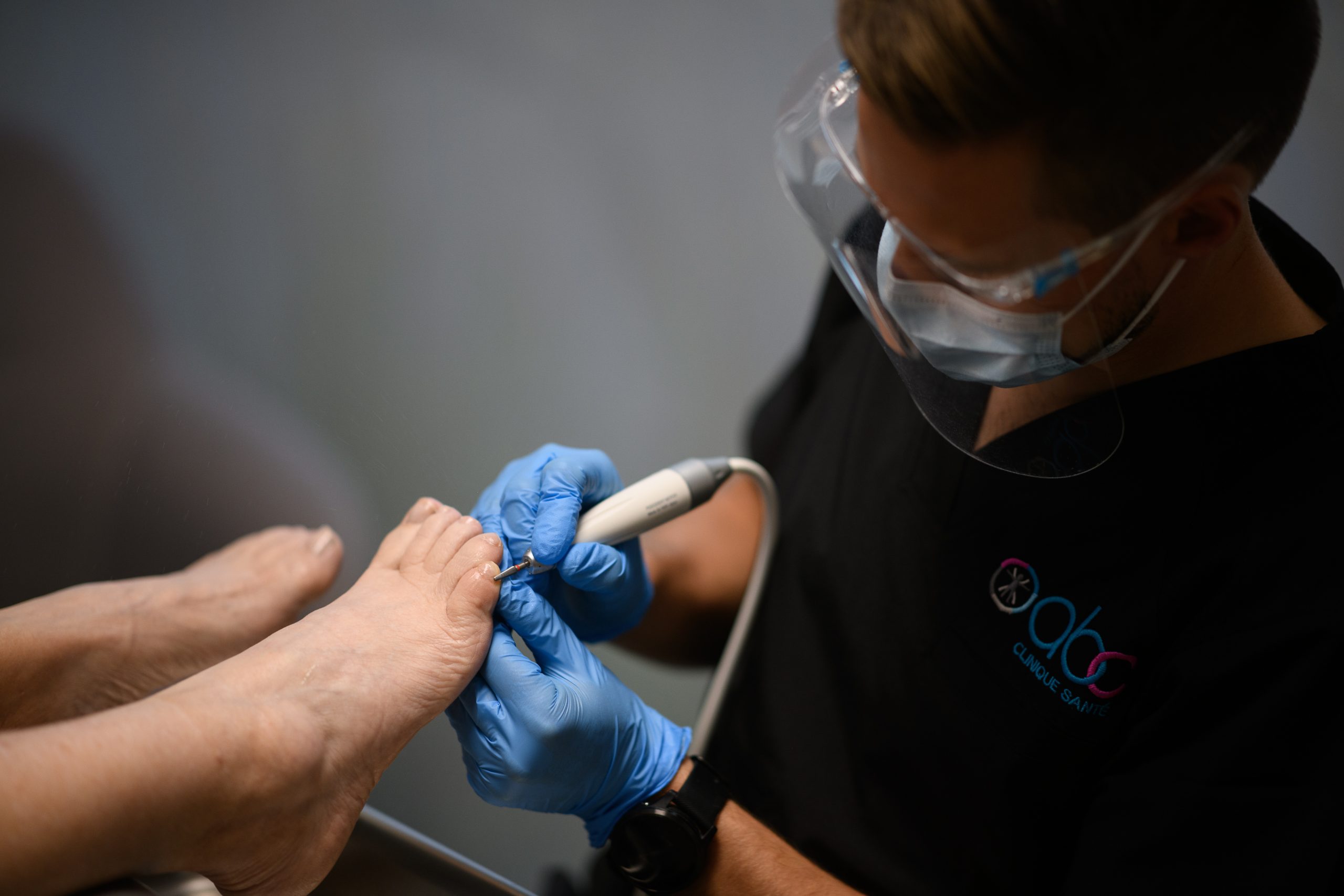You are about to schedule an appointment at ABC Health Clinic Vaudreuil-Dorion
Valleyfield: 450-371-0321
Vaudreuil-Dorion: 450-455-8500
Mirabel: 450-974-5928
Gatineau: 819-773-4230
Trois-Rivières: 819-801-1278
Boucherville: 450-356-1666
Virtual services : 450-455-8500 (1-866-222-6735)
Nail fungus
What is nail fungus? How do we catch it? How to cure it?
Don’t be afraid of advertisements and let’s demystify nail fungus! It is a fungal infection mainly divided into three categories (dermatophytes, non-dermatophytes and yeasts). Here we will guide you through the different appearances of yeast infection, how to prevent it and how to treat it.
Am I going to lose my nails?
There are several types of mycosis, the appearance of which will vary (do not always rely on the advertisement)! Typical signs may include heterogeneous nail discoloration, peeling, crumbly longitudinal ridges, thickening as well as debris under the nails. Loss of nails is not a consequence of mycosis! On the other hand, a traumatic detachment of the nail can include some of these characteristics and it is therefore not to be mistaken.
How do I know if I have yeast infection?
With the naked eye, the podiatrist can have a strong suspicion of nail fungus based on the characteristics of your nail. However, a culture is necessary to confirm this diagnosis. This culture will also allow your podiatrist to prescribe the appropriate treatment.
Am I at risk?
The fungus thrives in a warm, humid environment. It can affect the nail following a trauma, since it thus creates a sufficient entrance door for it to proliferate there. Athletes are therefore more at risk in relation to perspiration and impacts, hence its close link with athlete’s foot. Athlete’s foot (Tinea pedis) is a fungal skin infection most common between the toes that can cause itching, redness and burning.
What precautions can I take?
Nail fungus is contagious. It is therefore possible to be contaminated in public areas such as swimming pools, locker rooms, showers and training rooms. It can thus be transmitted within the same family in more favorable places such as the shower or by the joint use of a nail clipper.
When you are affected by mycosis, a good prevention is to disinfect your nail clipper with alcohol after each use to avoid transmitting it to unaffected nails.
It is therefore important to cut your nails short to minimize trauma, change your stockings to control perspiration, disinfect our bathroom more often and apply antiperspirant products on our feet and in our shoes. Wear your sandals in public places, it’s important!
How can I get rid of it?
The treatment chosen is mainly determined by the level of nail involvement, the result of the culture and the medical history. There are topical treatments (varnish) to apply to the nail and oral medications. In addition, the podiatrist can perform a good debridement / thinning of the nail in order to promote the penetration of topical products, which increases the effectiveness of your treatment.
What about nail polish?
Applying nail polish and removing it repeatedly can traumatize the nail as well as the cuticle, thus making it more prone to fungal infection. Keeping the polish on for a long period of time prevents you from having access to the appearance of the nail, which could allow a superficial infection to escalate without your knowledge.
Is the laser a good treatment for mycosis?
No, since July 2019, Health Canada has issued a press release indicating that laser treatment is not authorized for the treatment of nail fungus, given the lack of efficacy shown in studies on this subject.
https://www.canadiensensante.gc.ca/recall-alert-rappel-avis/hc-sc/2019/70553a-fra.php
Références:
1. Ameen M. et autres. British Association of Dermatologists’ guidelines for the management of onychomycosis 2014. British Journal of Dermatologists 2014. Consulté le 29 novembre 2019 : https://onlinelibrary.wiley.com/doi/pdf/10.1111/bjd.13358
2. Angelo, T., Borgheti Cardoso, L. N., Gelfuso, G. M., Taveira, S. F. et Gratieri, T. (2017). Chemical and physical strategies in onychomycosis topical treatment: A review. Medical Mycology. doi: 10.1093/mmy/myw084
3. Caputo R, De Boulle K, Del Rosso J, Nowicki R. Prevalence of super?cial fungal infections among sports-active individuals: results from the Achilles survey, a review of the literature. J Eur Acad Dermatol Venereol 2001; 15:312–16.
4. Gupta AK, Daigle D, Foley KA. Network Meta-Analysis of Onychomycosis Treatments.Skin Appendage Disord. 2015 Sep;1(2):74-81. doi: 10.1159/000433473. Epub 2015 Jun 26.
5. Gupta A, Drummond-Main C. Systematic review of nondermatophyte mold onychomycosis: diagnosis, clinical types, epidemiology, and treatment. J Am Acad Dermatol 2012; 66:AB122.
6. Westerberg DP, Voyack MJ. Onychomychosis: Current trends in diagnosis and treatment. Am Fam Physician. 2013, Vol 88 (11), 762-770.
7. Yin Z, Xu J, Luo D. A meta-analysis comparing long-term recurrences of toenail onychomycosis after successful treatment with terbina?ne versus itraconazole. J Dermatolog Treat 2012; 23:449–52.


